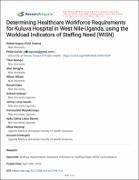| dc.contributor.author | Anguyo DDM Onzima, Robert | |
| dc.contributor.author | Govule, Philip | |
| dc.contributor.author | Apangu, Titus | |
| dc.contributor.author | Harogha, Alan | |
| dc.contributor.author | Wibale, Wilson | |
| dc.contributor.author | Debo, Ronald | |
| dc.contributor.author | Ambayo, Richard | |
| dc.contributor.author | Lulua Awudo, Jimmy | |
| dc.contributor.author | Maryekmungu, Immaculate | |
| dc.contributor.author | Likico Bayoru, Aziku Celina | |
| dc.contributor.author | Nanyingi, Miisa | |
| dc.contributor.author | Karengera, Innocent | |
| dc.date.accessioned | 2024-04-04T16:04:26Z | |
| dc.date.available | 2024-04-04T16:04:26Z | |
| dc.date.issued | 2023-04-29 | |
| dc.identifier.uri | http://hdl.handle.net/20.500.12280/3104 | |
| dc.description.abstract | Health workforce shortage is a major threat to global public health with a greater implication for low resourced countries. The right placement of the available staff in many health facilities remains a
challenge due to inadequate information on exact workload and work pressure that staff undergo in
course of work. This study aimed to determine the need for key health workforce cadre in Kuluva hospital
using Workload Indicators of Staffing Need (WISN) methodology.
The study followed a predominantly quantitative approach of Workload Indicator Staffing Needs (WISN)
methodology. We held a meeting with hospital management to understand policy issues and procedures.
The key staff were interviewed in departments, available records reviewed, practices observed to establish
the available working time, activity standards and time taken to perform other supportive activities.
Service statistics was generated from HMIS data of 2016/17. Data was analyzed manually using
calculator and Microsoft Excel spreadsheet.
All cadre categories had the same available working time of 1,504 hours in a year with 105 staff of the
studied cadres required to perform all activities in Kuluva hospital based on WISN calculation. Although
overall work pressure was 30%, 5 out of 7 staff cadre categories experienced work pressure of varying
degrees – medical officers (70%), laboratory staff (70%) and clinical officers (60%) were most affected
compared to nurses (30%) and midwives (10%). There was perfect number of anesthetists but surplus
nursing assistants than needed by the hospital. Amidst shortage, the critical cadres still spent significant
time on non-professional activities; medical officers (24%) and midwives (25%).
These findings can provide insight into the management of Kuluva hospital to address the current
disparities in the health workforce in terms of numbers and skill mix for continuous improvement of
health service delivery to the population it serves. | en_US |
| dc.language.iso | en | en_US |
| dc.publisher | Research Square | en_US |
| dc.relation.ispartofseries | Research Square; | |
| dc.subject | Staffing requirements | en_US |
| dc.subject | Work pressure | en_US |
| dc.subject | Workload indicators of staffing need (WISN) | en_US |
| dc.title | Determining Healthcare Workforce Requirements for Kuluva Hospital in West Nile-Uganda, using the Workload Indicators of Staffing Need (WISN) | en_US |
| dc.type | Preprint | en_US |


